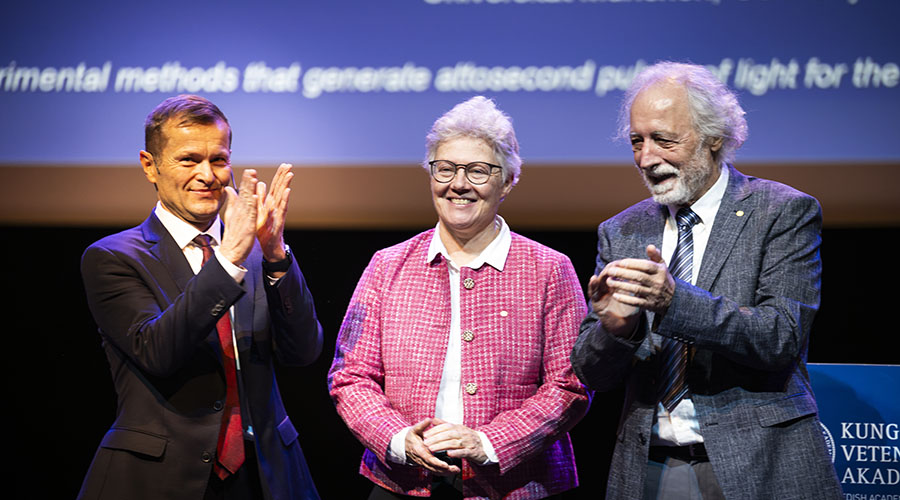
February 2024 (Volume 33, Number 1)
At the Nobel Lectures, Laureates Discussed Their Work Illuminating Electrons
The physics laureates shared their stories with the public in Stockholm.
By Abigail Dove | January 11, 2024

Credit: © Nobel Prize Outreach / Photo: Nanaka Adachi
The 2023 physics Nobel laureates in physics — Krausz, L’Huillier, and Agostini — after delivering lectures on Dec. 8, 2023, at Stockholm University.
The Nobel Prize is one of science’s most prestigious honors, recognizing individuals who have “conferred the greatest benefit to humankind.” The prize’s founder, Alfred Nobel, was born in Sweden’s capital, Stockholm, which today is the epicenter of Nobel Prize festivities and the site of the secretive committees that select the prizewinners.
But while the Nobel Prize Ceremony is a closed-door affair, members of the public can join the festivities by attending the Nobel lectures, where the laureates speak. The event is free to anyone, provided they line up early enough in Stockholm’s famously cold winter weather.
The 2023 Nobel Prize in Physics was awarded for the development of techniques to produce pulses of light so brief that they are measured in “attoseconds” (10-18 seconds, or a billionth of a nanosecond), thus enabling the study of the ultra-fast movement of electrons inside atoms and molecules.
Even in a field famous for probing the extremely large and the extremely small, the scale of attosecond physics is dizzying: There are as many attoseconds in one second as there are seconds in the 13.8 billion years since the Big Bang. But electrons move at a blistering 43 miles per second, so flashes of light on the order of attoseconds are the only ones brief enough to provide a snapshot of an electron’s motion.
It was the pioneering work of Anne L’Huillier (Lund University), Pierre Agostini (Ohio State University), and Ferenc Krausz (Max Planck Institute/Ludwig-Maximilian University) that opened the world of electrons for all to see. On Dec. 8, in a packed auditorium at Stockholm University, each took the stage to tell their story.
L’Huillier — only the fifth female laureate in the history of the physics Nobel Prize — laid the groundwork for the field by studying the light emitted from shining lasers through noble gases. In the late 1980s, L’Huillier discovered that when an infrared laser was shone through ionized argon, the resulting light waves had increasingly high frequencies, a phenomenon called harmonic generation. “It’s similar to what happens when the bow of a violin hits the string,” L’Huillier said in her lecture. “It produces not only the intended note, but also overtones.”
L'Huillier theorized that if two harmonic waves were aligned just right, they could interact in a way that generated extremely short flashes of light. “Think of a gigantic orchestra where all the musicians need to keep the same pace,” she explained. “Except each musician in this orchestra is an atom, and there are trillions involved.”
As laser technology advanced, physicists raced to make attosecond pulses a reality. In 2001, Agostini did just that. His team was able to generate a train of consecutive ultra-fast light pulses thanks to an ingenious setup in which a laser light was divided into two beams, refracted through a series of glass windows, and then brought together again, ensuring correct synchronization of the harmonic waves. Agostini was also able to measure the pulses, which clocked in at an astonishing 250 attoseconds.
With characteristic humility, Agostini emphasized how much these methods have improved. “This was 20 years ago,” he said. “The pulses have now shrunk to 43 attoseconds, and soon we’ll have the zeptosecond” (10-21).
But the progress can’t continue forever, according to quantum mechanics. “It takes more and more energy to produce shorter and shorter pulses, and eventually we will hit Planck time (10-44 seconds) — that’s the absolute limit,” he added.
With the technology to create attosecond pulses in hand, physicists sought to use them to snapshot electrons in motion. In 2010, Krausz’s team used attosecond spectroscopy to capture high-speed phenomena, including the photoelectric effect (in which light rips electrons from an atom) and the oscillations of a cloud of electrons around a nucleus. “Attosecond spectroscopy furnishes us with a temporal magnifying power that is equivalent to the combined magnifying power of a space telescope and an electron microscope,” Krausz said.
In his lecture, Krausz highlighted the application of attosecond spectroscopy to biological materials as one of the most impactful future uses of the technology. His team has already embarked on this: By identifying “electric field molecular fingerprints” associated with cancer, Krausz’s team has been able to distinguish between blood samples of early-stage lung cancer patients from healthy controls with >90% accuracy — an encouraging sign that this technology may one day be harnessed for disease detection.
The science behind this year’s Nobel Prize is impressive, but one of the most moving aspects of the event was each laureate’s humility. All three gave heartfelt acknowledgements to their mentors, colleagues, and former students, many of whom sat in the front row of the audience.
Krausz also highlighted another champion of physics — the next generation of scientists. “Children everywhere deserve the chance to realize their dreams,” he said to applause. “We badly need all of them to carry on once our own time comes to an end.” He will donate his share of the 11 million SEK in prize money (~$1,080,000) to support education programs for children whose schooling has been disrupted by the war in Ukraine.
Abigail Dove is a writer based in Stockholm, Sweden.
©1995 - 2024, AMERICAN PHYSICAL SOCIETY
APS encourages the redistribution of the materials included in this newspaper provided that attribution to the source is noted and the materials are not truncated or changed.
Editor: Taryn MacKinney
February 2024 (Volume 33, Number 1)
Articles in this Issue
